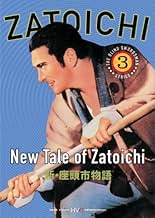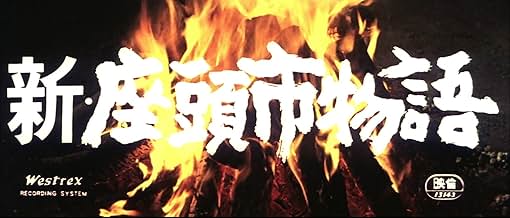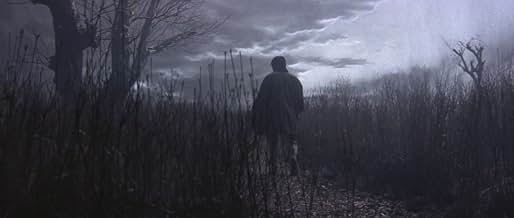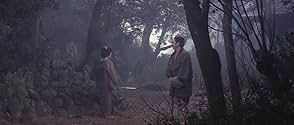La légende de Zatoïchi - Un nouveau voyage
Original title: Shin Zatôichi monogatari
IMDb RATING
7.3/10
2.5K
YOUR RATING
Wishing to find peace, Zatoichi travels to his old village but only finds trouble when he ends up in a love triangle and finds old scores have followed him home.Wishing to find peace, Zatoichi travels to his old village but only finds trouble when he ends up in a love triangle and finds old scores have followed him home.Wishing to find peace, Zatoichi travels to his old village but only finds trouble when he ends up in a love triangle and finds old scores have followed him home.
- Director
- Writers
- Stars
- Awards
- 1 nomination total
- Director
- Writers
- All cast & crew
- Production, box office & more at IMDbPro
Featured reviews
'New Tale Of Zatoichi (1963)' sees its eponymous blind swordsman/masseur return to the town in which he was trained, followed by his reputation and the repercussions of the prior movie's events. Once again, it's a relatively meditative character study at heart. With flashes of fast-paced, decisive action and a background plot focused on a kidnapping, the picture ebbs and flows until it reaches its melancholic yet explosive finale. It's a little bit scatterbrained and doesn't have the strongest of central threads; the closest thing to a proper through-line is probably an ill-fated romance that brings out the best in Zatoichi but the worst in his master. In general, the movie is enjoyable. Plus, its shift to colour has little impact on its overall look and feel. Even if it isn't as solid as its two predecessors, it's still well-made and engaging. 7/10
I recently rewatched The New Tale of Zatoichi (1963) on a random streaming service. The storyline follows Zatoichi as he returns home seeking peace. However, he finds anything but-his hometown is threatened by a local mob, the brother of a man he killed is tracking him down, and two women fall in love with him. Can Zatoichi save himself and his townspeople from these challenges?
Directed by Tokuzô Tanaka (The Haunted Castle), the film stars Shintarô Katsu (*Hanzo the Razor), Mikiko Tsubouchi (Yokai Monsters: 100 Monsters), Seizaburô Kawazu (Yojimbo), and Fujio Suga (The Master Spearman).
Shintarô Katsu is fantastic in all of these movies, but it's especially fun to watch a younger depiction of his character. Zatoichi is an easy character to root for-always noble and righteous. I always hope he'll get the girl in the end, even when you know how things are likely to conclude. The female lead in this film is both compelling and complex, making her someone you can root for and against. The overall storyline is intricate, well-written, and a pleasure to watch unfold. The choreography is top-notch, with a thrilling opening fight at a bar, a dynamic battle when he first arrives in town, and a final samurai showdown that could go either way. There's a lot to appreciate here.
In conclusion, The New Tale of Zatoichi is another worthwhile entry in this series and an absolute must-see. I would score it a 7.5/10 and strongly recommend it.
Directed by Tokuzô Tanaka (The Haunted Castle), the film stars Shintarô Katsu (*Hanzo the Razor), Mikiko Tsubouchi (Yokai Monsters: 100 Monsters), Seizaburô Kawazu (Yojimbo), and Fujio Suga (The Master Spearman).
Shintarô Katsu is fantastic in all of these movies, but it's especially fun to watch a younger depiction of his character. Zatoichi is an easy character to root for-always noble and righteous. I always hope he'll get the girl in the end, even when you know how things are likely to conclude. The female lead in this film is both compelling and complex, making her someone you can root for and against. The overall storyline is intricate, well-written, and a pleasure to watch unfold. The choreography is top-notch, with a thrilling opening fight at a bar, a dynamic battle when he first arrives in town, and a final samurai showdown that could go either way. There's a lot to appreciate here.
In conclusion, The New Tale of Zatoichi is another worthwhile entry in this series and an absolute must-see. I would score it a 7.5/10 and strongly recommend it.
Usually long film series see a gradual development or deconstruction of the main character simply because either the character changes or the environment does. Most often our heroes are marched through various situations, numerous more often than not, and only when the ticket sales start to diminish there's usually a twist in the hero's personality or identity.
There's a third way, too. It has to do with the filmic problem of presentation, and usually this happens when the film is made during a historically significant technological paradigm shift. Sound was one, and nowadays it's most likely 3D, although more because of the commercial powers behind the technology. In the 1960s it was colour.
With Zatōichi its introduction in this third film becomes deliciously ironic, since in the first two films there have been several japes different people play on Ichi because he's blind. In those moments we, the audience, have been able to see it with them, making us part of the bad guys' gang as well. This cinematically fruitful branch of narrative play extends here to the very form of the film itself – its colour.
As a colour film this a very beautiful one. It's more inclined towards the subdued than the showy, and that's commendable. It's also more interested in characterization, really casting the second film in more realistic light as an afterthought. What's so striking is that while it's customary to have the hero denounce his craft and want to lead a normal life, it's usually fluff that lasts only a while. Not so here: Ichi really wants to quit, and promises to. It's made feasible, it makes sense. It feels like the right thing to do. But still we know that won't happen, that the torment will continue, and in part that's why we cheer for Ichi, that he might go on. They manage to make Ichi's torment our own. It really is expertly handled.
Among the best in the series so far.
There's a third way, too. It has to do with the filmic problem of presentation, and usually this happens when the film is made during a historically significant technological paradigm shift. Sound was one, and nowadays it's most likely 3D, although more because of the commercial powers behind the technology. In the 1960s it was colour.
With Zatōichi its introduction in this third film becomes deliciously ironic, since in the first two films there have been several japes different people play on Ichi because he's blind. In those moments we, the audience, have been able to see it with them, making us part of the bad guys' gang as well. This cinematically fruitful branch of narrative play extends here to the very form of the film itself – its colour.
As a colour film this a very beautiful one. It's more inclined towards the subdued than the showy, and that's commendable. It's also more interested in characterization, really casting the second film in more realistic light as an afterthought. What's so striking is that while it's customary to have the hero denounce his craft and want to lead a normal life, it's usually fluff that lasts only a while. Not so here: Ichi really wants to quit, and promises to. It's made feasible, it makes sense. It feels like the right thing to do. But still we know that won't happen, that the torment will continue, and in part that's why we cheer for Ichi, that he might go on. They manage to make Ichi's torment our own. It really is expertly handled.
Among the best in the series so far.
New Tale of Zatoichi is the third entry in the franchise centered around the skilled blind swordsman with the strong moral compass. It's also the first movie of the franchise to be shot in color. However, it's also the weakest part of the franchise thus far but still an above average experience. Zatoichi is hunted down by the family of a yakuza he killed in the previous film when he is unexpectedly saved from trouble by his former master. He agrees to stay with his former master and his younger sister and also visits his solitary grandmother. What seems to be a joyous reunion soon turns sour when Zatoichi realizes how his master has changed for the worst. His former master tries to marry his sister to a man whom she doesn't love, kills unarmed people for unjustified reasons and cooperates with a ruthless gang of criminals by taking advantage of his pupils' rich parents. Zatoichi can't ignore the truth and ends up challenging his former master to a decisive duel.
The third installment of the Zatoichi franchise must be separated into two parts. The first half of the movie is quite pointless and could also be told in five minutes or less. We follow Zatoichi traveling across rural Japan and meeting former friends and foes. The movie plods along and is only average at best because of an imprecisely meandering plot. Up to that point, the film could be considered an at best average slice of life or road movie. Things however improve by a few notches when his former master's sister proposes to Zatoichi. From then on, the characters are developed in depth, philosophical topics such as dishonor and honor are discussed and the movie skillfully mixes beautiful fight choreography with a tragic love story. The second half of the film is the most emotional passage of the franchise as we witness Zatoichi's desperate quest for love, peace of mind and renaissance which he simply cannot find as he is constantly challenged, judged and haunted by the demons of his past.
In the end, despite being the least interesting part of the franchise thus far, New Tale of Zatoichi is still worth your attention because of an emotional second half that pardons for a plodding first half. The movie stands out with a sad, melancholy and gloomy touch and makes the viewer empathize with the haunted swordsman more than ever before. Fans of the franchise should definitely watch this film while occasional martial arts fans should rather try out the first installment, The Tale of Zatoichi.
The third installment of the Zatoichi franchise must be separated into two parts. The first half of the movie is quite pointless and could also be told in five minutes or less. We follow Zatoichi traveling across rural Japan and meeting former friends and foes. The movie plods along and is only average at best because of an imprecisely meandering plot. Up to that point, the film could be considered an at best average slice of life or road movie. Things however improve by a few notches when his former master's sister proposes to Zatoichi. From then on, the characters are developed in depth, philosophical topics such as dishonor and honor are discussed and the movie skillfully mixes beautiful fight choreography with a tragic love story. The second half of the film is the most emotional passage of the franchise as we witness Zatoichi's desperate quest for love, peace of mind and renaissance which he simply cannot find as he is constantly challenged, judged and haunted by the demons of his past.
In the end, despite being the least interesting part of the franchise thus far, New Tale of Zatoichi is still worth your attention because of an emotional second half that pardons for a plodding first half. The movie stands out with a sad, melancholy and gloomy touch and makes the viewer empathize with the haunted swordsman more than ever before. Fans of the franchise should definitely watch this film while occasional martial arts fans should rather try out the first installment, The Tale of Zatoichi.
This is the third entry in the popular Zatoichi series, and as usual it features an outstanding performance from Shintaro Katsu as the blind masseur who is also a master of sword play. This time he takes on a gang of thieves who are marauding the countryside. Of particular note is Akira Ifubuke's brilliant and evocative score, reminiscent of his best work from kaiju.
Did you know
- TriviaThis is the first Zatoichi movie to be shot in colour.
- ConnectionsFeatured in Best in Action: 1963 (2019)
- How long is New Tale of Zatoichi?Powered by Alexa
Details
- Release date
- Country of origin
- Language
- Also known as
- New Tale of Zatoichi
- Production company
- See more company credits at IMDbPro
- Runtime1 hour 31 minutes
- Aspect ratio
- 2.35 : 1
Contribute to this page
Suggest an edit or add missing content

Top Gap
By what name was La légende de Zatoïchi - Un nouveau voyage (1963) officially released in India in English?
Answer


























